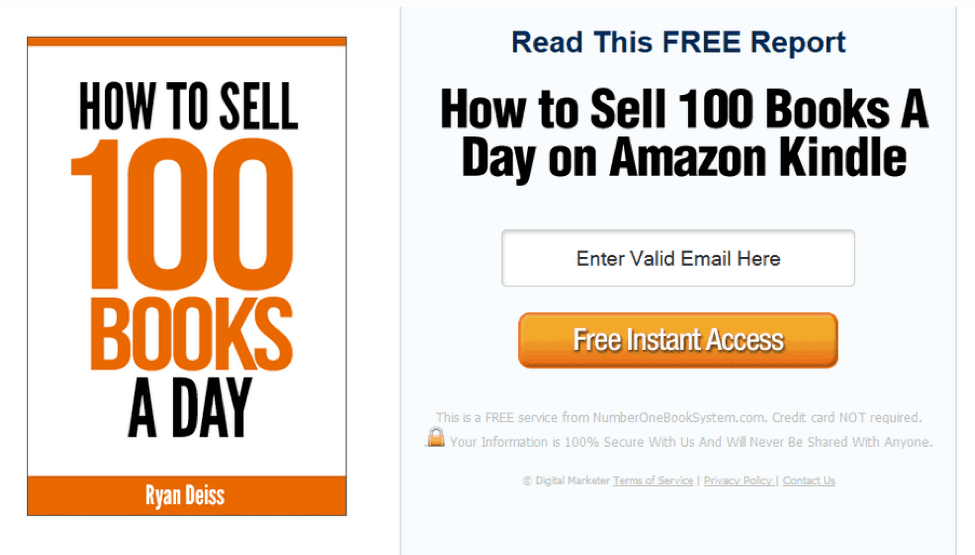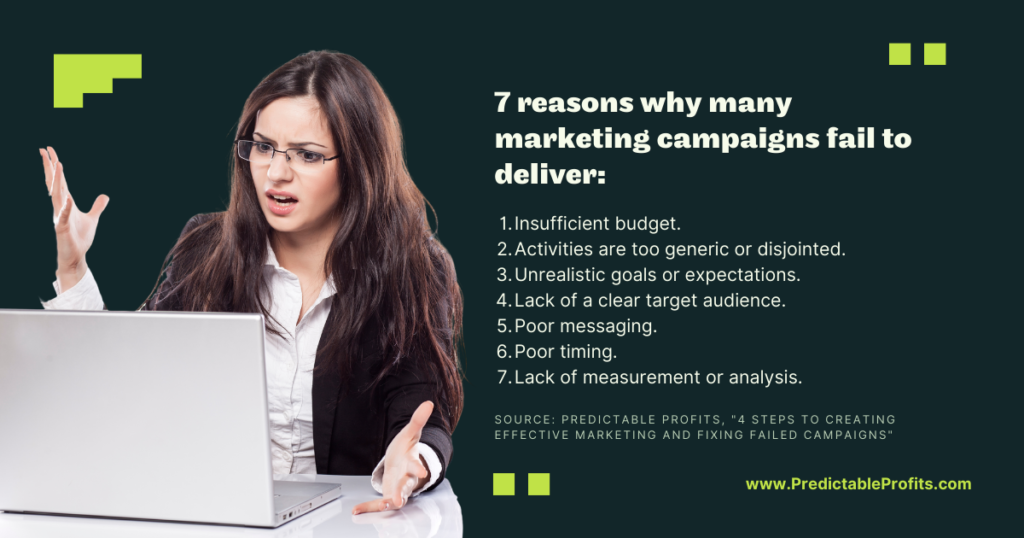Are you tired of launching bad digital marketing campaigns that fall flat? Creating an effective marketing campaign can be challenging, but following these four steps can improve your chances of success and fix any marketing fails you might have.
Whether you’re a small business owner or a marketing professional, these steps will help you create campaigns that resonate with your target audience and achieve your desired outcomes.
Have you ever launched a marketing campaign only to have it fail? It’s a discouraging feeling, and yet it is far too common. Fortunately, some steps can be taken to ensure engaging and effective campaigns.
On a more basic level, your marketing campaigns should focus on your target audience, have goals and objectives, have the right mix of marketing channels, and is then tracked and analyzed for further optimization.
Beyond that, however, there are further considerations to ensure your marketing campaigns. Keeping some of these key concepts in mind should also help you fix any previous failed campaigns.
Why Do Marketing Campaigns Fail?
According to experts, there are several common reasons why marketing campaigns fail.
- Insufficient budget: Not having enough resources to execute a campaign properly can limit its success. A campaign not running for long enough couldn’t possibly build up much-needed momentum to succeed. (Source)
- Being too generic: They are not ongoing, connected activities aimed at a specific goal. This can happen if a business sends out occasional emails or sponsors a conference but doesn’t consider them part of a larger marketing campaign.
- Unrealistic expectations. Setting unrealistic goals or expecting immediate results can lead to disappointment and failure.
- Failure can also include a lack of a clear target audience, poor messaging, poor timing, and lack of measurement or analysis.
While these are the most common reasons why campaigns fail, it is important to understand the root cause of a failed marketing campaign to fix it and make necessary changes and improvements to ensure future success.
Do You Even Have a Marketing Strategy?
According to the Sales Benchmark Index, an estimated 71% of companies fell short of their marketing campaign revenue targets in 2015.
Why? …And what happened?
Well, according to the management consulting firm’s report, the primary reason for such widespread failure was that too many companies used the wrong strategies.
Or, more specifically, they didn’t have a marketing strategy at all.
Instead, they relied on tactics.
A tactic might be something like hiring someone to do social media… Or SEO… Or to create content for a website or direct-mail piece.
And when you do this, there often isn’t a thought – much less a strategy in place – to develop and continuously test your efforts…
…At least as it relates to lead generation or sales.
Then, companies jump from tactic to tactic based on what’s popular at the moment or after watching what the competition does.
Of course, this might lead to an occasional lucky break, but it makes creating successful marketing campaigns pretty difficult.
So, as you go through the following steps, think about your marketing campaign efforts and whether you’re using a marketing strategy or just relying on tactics.
Setting suitable objectives and identifying strategies or opportunities are vital to business growth. Nevertheless, you must turn your ideas into actions to achieve your end goals. Read about tactical planning in this related piece.
Do You Remember Your Best Digital Marketing Campaign Ever?
The other thing to think about is a simple question…
What was the best marketing campaign you ever used?
I’m often surprised by how few entrepreneurs and executives use successful campaigns from the past. They get distracted by a new tool or technique and disregard what’s already working.
Maybe a competitor jumps on something different, so they feel they must do the same thing… Or they get lured by the promise of marketing’s “holy grail” and a ridiculous ROI.
It sounds like silly stuff…
Yet, I’ve admittedly fallen in this trap too.
The lesson here is to keep doing more of what works.
As entrepreneurs and executives, we’re really good at starting stuff. We run into challenges when we must keep pushing (and improving) activities already producing.
We naturally like starting new things.
The problem is, effective marketing works a lot like food. It feeds businesses so they can grow.
You starve your business when you move your attention all around – constantly trying all types of different outreach.
So what’s working in your marketing that you can do more of right now?
Digital marketing solutions are all the rage these days, but is direct mail marketing still an effective strategy in an increasingly digital world? Find out in our related piece on direct mail marketing.
How Do I Create More Effective Marketing Efforts?
Okay, with those two items out of the way, let’s get into the four steps for creating effective marketing and fixing failed marketing campaigns.
Step 1: Evaluate Your Audience
Simply put, your audience must match what’s being offered.
So, consider this…
If you had to pick between delivering a powerful marketing message to a large audience of people or selecting a small group of prospects to receive a poor marketing message, which would you choose?
My answer might surprise you.
You see, I’ll take the small group of prospects and poor marketing message almost every time.
After all, when put in front of the wrong audience, even the most persuasive marketing messages get ignored. Of course, this fact goes against advice you often hear from sales trainers.
Many say you should play the “numbers game.” Get in front of more people, and you’ll get more sales.
Sure, there’s some truth to this claim, but marketing to people who haven’t expressed interest in what you offer drains resources.
You simply can’t create desire where none exists – you can only deepen a desire that’s already present. Trying to convince people they need your product or service will only leave you frustrated and your wallet thinner.
Buying an ad in your local newspaper or magazine because you want your message in front of thousands of eyeballs doesn’t guarantee marketing success.
…Neither does posting a banner on a highly trafficked website… Mailing to large lists of nearby homes or businesses… Growing a huge following on social media… Securing a full-page spread in the Yellow Pages… Or even buying a commercial spot during the Super Bowl.
The list could go on.
So, before you roll out a major marketing campaign, make sure your marketing medium reaches an audience that has already expressed a desire for your offer.
2. Evaluate Your Headline and First Sentence

“Most sales are made or lost within the first 10-15 seconds.”
Ben Gay III Tweet
If you follow traditional sales philosophy, you might argue that most sales close at the end of your “presentation” or after several contacts.
Yet, as you see from the above advice shared by two sales and marketing legends, many prospects make buying decisions almost instantly.
Unfortunately, these findings present a problem when marketing – at least for those entrepreneurs and executives who make the same pitches and promises as their competitors.
Problems escalate further if your marketing doesn’t demonstrate a desire to help in a way that benefits someone other than you.
The key (early on) with your marketing piece is to interrupt your prospects’ mental patterns.
Every day your marketing message is up against 50,000 invisible competitors.
This is the number of thoughts the National Science Foundation says the average person has every day. Crazy thing is, up to 95% of these thoughts are just repeated from one day to the next.
Our brains are set in a mental routine. Breaking this pattern is your only chance at getting your marketing message noticed.
You see, most marketing is just a bunch of companies saying the same ol’ stuff. So, your first job is to get prospects to recognize that you have something worthy of their attention.
This is where a pattern interruption comes into play.
“Seventy-three percent of all buying decisions are made at the point of the headline.”
John Caples Tweet
As the name implies, you simply do something or make a statement that changes a particular thought or situation. Your message should serve as a surprise – anything out of the ordinary.
Magazine covers have used this tactic for a long time…
Now, of course, these are exaggerated examples – but they at least give you an idea of how important the headline is in grabbing attention.
A poor headline makes your marketing invisible.
Keep in mind, though, your headline isn’t designed to sell – it’s just to get readers to the next sentence.
One of the easiest ways to write powerful headlines – that capture attention and keep prospects reading – is by using what I call The Genie Method.
Begin by envisioning yourself having a face-to-face conversation with your ideal prospect.
Next, just like the genie who appears from Aladdin’s lamp, imagine telling that prospect you can grant any wish related to your business.
Here’s what you might say:
“If I could use my product or service to grant you one wish, what would it be?”
Your prospect’s response is what is sometimes labeled a “hidden benefit.” Here’s an example from one of my lawyer clients’ website:

Here’s the same headline format used by PayPal:

Another option for grabbing a reader’s attention and keeping interest is the “how-to” headline…

You can also call out your audience…

Now, besides your headline, you must also keep the momentum going with your first sentence.
This absolutely critical – but often overlooked…
Mess up your first sentence, and you’re almost certainly missing out on leads and paying clients. Especially if you post content online, you must provide a compelling reason to keep your prospects reading.
The bottom line is: keep your readers interested and you’ll started getting more of the responses you want.
Step 3: Evaluate Your Format
Imagine you’re sitting on a sandy beach with only the sounds of the waves and a few distant seagulls.
Would you reach into your bag and pull out one of your old term papers for some relaxing reading?
Of course not.
The stiff style of writing we learned in school isn’t enjoyable and doesn’t work for marketing campaigns. You’re better off writing as if you’re having a one-on-one conversation – just as if you’re talking to a friend.
It doesn’t matter who you’re selling to – attorneys, bankers, stay-at-home moms – your writing should speak to one person at a time.
Marketing is just an extension of a one-on-one discussion. The only difference is, depending on the medium you use, you’re sharing an identical message with multiple people.
Sure, you might have to adjust your vocabulary a bit to match your audience, but everything you write should sound like a real person speaking – not like a term paper.
A good rule of thumb is:
If you wouldn’t say something in a one-on-one conversation with a prospect, don’t say it in your marketing materials.
Here’s an example of what NOT to do:

What do all these worthless words mean?
According to the National Adult Learning Survey, the average adult reads at the 9th grade level. Blockbuster novels are written at the 7th grade level.
People prefer to read recreationally two grades below their actual reading skill – so avoid writing higher than a 6th or 7th grade level.
You can check the level of your writing using a tool in Microsoft Word.
- Click the “File” tab, and then click “Options”
- Click “Proofing”
- Under “When correcting spelling and grammar in Word,” make sure the “Check grammar with spelling check box” is selected
- Select “Show readability statistics”

Then you simply run a spelling and grammar check. At the end, a box shows up with your Flesch-Kincaid Reading Level.
The simplest way to lower your level is by using short sentences and paragraphs. You can even use one-sentence paragraphs.
This approach may make your high school English teacher cringe, but your content will be more readable.
In addition, replace long words (anything with three syllables or more) wherever possible.
I also encourage you to read your marketing aloud and even have someone else read it to you. If you have kids, this is a perfect task for them.
After all, if your 10 or 12-year-old stumbles through your content, you know you have work to do.
Another idea you must accept…
People scan your marketing rather than read it in detail – especially the first time around.
So, emphasize key points with bolding or by using subheadings, which are a great way to break up your content. Use your subheads almost like mini headlines to keep people reading.
And here’s a secret:
Once you finish writing, go back and read just your bolding and headings. If your readers can get the gist of what you’re saying or offering, then you’ve done a good job.
Step 4: Evaluate Your Offer

Too many times, you see a well-written marketing piece with a compelling headline, nice format, clean images, and a bunch of benefits…
…But NO offer!
Instead of telling readers what action to take next, all that’s listed in a phone number and website.
What a waste of space…
You must tell prospects what to do if you want them to respond – and be bold.
Creating a compelling offer begins with understanding your target audience’s biggest problem. Then, you simply use your offer to solve this issue.
Ancestry.com does this well…

Notice how the offer ties right into the reason people come to the website.
Keep in mind, you can often boost response to your marketing campaigns by explaining what prospects lose by not taking action on your offer.
So, for instance, here’s a good offer:
Click here to try the next three issues of The Business Owner’s Tax Savings Report for free. You’ll get simple tax-saving tips and discover how to save on real estate, insurance, car repairs, and more.
But here’s a better one:
Click here to try the next three issues of The Business Owner’s Tax Savings Report for free. You’ll get simple tax-saving tips and discover how to save on real estate, insurance, car repairs, and more.
Without these strategies, you’re almost certain to overspend on taxes this year. What’s more, you put yourself at greater risk for paying penalties – even if you hire a conservative accountant and don’t take a single “questionable” deduction. Download your first issue now.
The final element of an effective offer is a deadline. Few forces create action faster than a deadline. It’s a powerful tool for rewarding action-takers.
You see, by allowing prospects to determine the buying timeframe, you reduce the likelihood of getting your desired response. Worse yet, your prospects may get lured away by another offer.
Remember, people are natural procrastinators.
When you create a sense of immediacy, prospects realize they must respond now or risk missing out on a valuable opportunity.
As Robert Cialdini stressed in his book, Influence: The Psychology of Persuasion, “We value more those things that have recently become less available to us.”
So, simply figure out what has the most meaning to your potential buyers and set your deadline around that specific motivation.
NOTE: The added bonus of a deadline is that you’re working with a reason to communicate again via a follow-up.
A Final Word on Creating Effective Marketing Campaigns (and Fixing Failed Efforts)
Suppose you’re looking to launch a successful marketing campaign. In that case, the key is to have a solid marketing strategy: research your audience, set goals and objectives, choose the right platforms, and track your results consistently.
Then take a step back and evaluate your strategy for relevance:
- Is this strategy right for your audience?
- Are you creating a good impression with a great headline (and first sentence)?
- Are you using the right format for your audience?
- Do you have a compelling enough offer for this campaign?
Then you can sit back and watch your amazing campaigns drive growth for you and your business.
Take the necessary steps to create effective marketing strategies and fix failed campaigns. Your business can drive substantial growth and reach its long-term goals.
Ready to take your marketing campaigns to the next level? Consider investing in growth consulting and business coaching to get the most out of your efforts. With our help, you can create powerful strategies and gain insight into the best practices for developing successful campaigns. Contact us today to get started!
Be part of our ever-growing community of seven- and eight-figure business owners:
- Check us out on the Predictable Profits YouTube channel.
- Connect with us on Linkedin.
- Join other entrepreneurs (like yourself) on our Facebook page.
- And if you haven’t already, sign up for our daily business coaching video series (by entering your email address below).








